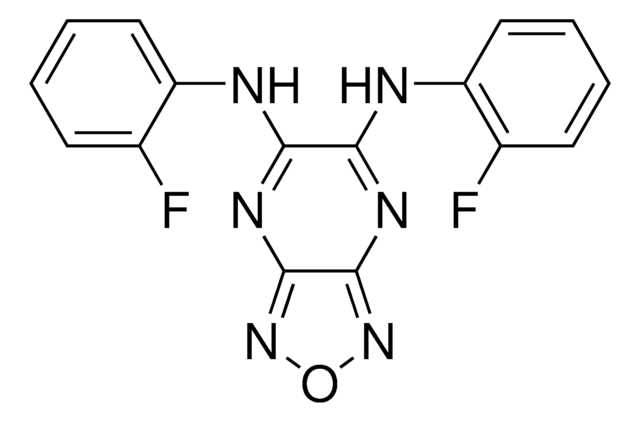A8674
Antimycin A from Streptomyces sp.
Synonym(s):
Antipiricullin
About This Item
Recommended Products
form
powder
Quality Level
antibiotic activity spectrum
fungi
Mode of action
enzyme | inhibits
storage temp.
−20°C
SMILES string
[H]C(=O)Nc1cccc(C(=O)N[C@H]2[C@@H](C)OC(=O)C(CCCCCC)[C@@H](OC(=O)CC(C)C)[C@H](C)OC2=O)c1O
InChI
1S/C28H40N2O9/c1-6-7-8-9-11-20-25(39-22(32)14-16(2)3)18(5)38-28(36)23(17(4)37-27(20)35)30-26(34)19-12-10-13-21(24(19)33)29-15-31/h10,12-13,15-18,20,23,25,33H,6-9,11,14H2,1-5H3,(H,29,31)(H,30,34)/t17-,18+,20?,23+,25+/m1/s1
InChI key
UIFFUZWRFRDZJC-RBVQMQRASA-N
Looking for similar products? Visit Product Comparison Guide
General description
Application
- as a respiratory chain inhibitor in neuronal cultures
- in organello ATP production assay in Trypanosoma brucei cells
- in respiration assay for papillary thyroid carcinoma (PTC) cell lines
Biochem/physiol Actions
Quality
Signal Word
Danger
Hazard Statements
Precautionary Statements
Hazard Classifications
Acute Tox. 2 Oral - Aquatic Acute 1
Storage Class Code
6.1A - Combustible acute toxic Cat. 1 and 2 / very toxic hazardous materials
WGK
WGK 3
Flash Point(F)
Not applicable
Flash Point(C)
Not applicable
Personal Protective Equipment
Regulatory Listings
Regulatory Listings are mainly provided for chemical products. Only limited information can be provided here for non-chemical products. No entry means none of the components are listed. It is the user’s obligation to ensure the safe and legal use of the product.
JAN Code
A8674-50MG:
A8674-BULK:
A8674-VAR:
A8674-25MG-PW:
A8674-25MG:
A8674-50MG-PW:
A8674-100MG:
A8674-10MG:
A8674-100MG-PW:
Certificates of Analysis (COA)
Search for Certificates of Analysis (COA) by entering the products Lot/Batch Number. Lot and Batch Numbers can be found on a product’s label following the words ‘Lot’ or ‘Batch’.
Already Own This Product?
Find documentation for the products that you have recently purchased in the Document Library.
Customers Also Viewed
Our team of scientists has experience in all areas of research including Life Science, Material Science, Chemical Synthesis, Chromatography, Analytical and many others.
Contact Technical Service











